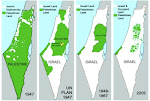Horrors - Ancient Arms Caches along Sinai's Way of Horus, claims Haaretz

Worryingly close to Rafah, archaeologists have uncovered huge weapons caches in the Sinai, at least according to a report published in today's Haaretz newspaper. It then recaps an agency reporter's tale about 4 Egyptian temples found along the Road of Horus. Reading beteen the lines, it seems that there were no actual weapons left to be found, but impressively big buildings with enough room to store them. Speculative reporting like this shows the same skewed logic that assumed a warehouse in Syrian wasteland which had been visited by North Koreans must hold a nuke reactor and should be secretly obliterated by the IDF. True, too many present day weapons get smuggled into Gaza along these ancient military routes, and then by burrowing under the border fences. Perhaps the headline writer couldn't resist the usual newsy phrases, particularly since the announcement, four months after arrests, that the Sinai was Hezbollah's latest hotspot for plotters.
Arms Storehouse Uncovered in Sinai
Archaeologists exploring an old military road in the Sinai have unearthed four new temples amidst the 3,000-year-old remains of an ancient fortified city that could have been used as a stronghold during the Egyptian occupation of Mesopotamia and Canaan, and to impress foreign delegations visiting Egypt, antiquities authorities announced Tuesday.
Archaeological findings have determined that a series of fortresses were built in the area and were used as weapons storehouses for soldiers traveling northwards. One source, a wall painting found in the Karnak temple in Luxor, depicts 11 strongholds built in northern Sinai
Among the discoveries was the largest mud brick temple found in the Sinai with an area of 70 by 80 meters (77 by 87 yards) and fortified with mud walls 3 meters (10 feet) thick, said Zahi Hawass, chief of Egypt's Supreme Council of Antiquities.
The find was made in Qantara, 2 1/2 miles (4 kilometers) east of the Suez Canal. These temples mark the latest discovery by archaeologists digging up the remains of the city on the military road known as "Way of Horus." Horus is a falcon-headed god, who represented the greatest cosmic powers for ancient Egyptians.
The path once connected Egypt to Palestine and is close to present-day Rafah, which borders the Palestinian territory of Gaza. Archaeologist Mohammed Abdel-Maqsoud, chief of the excavation team, said the large brick temple could potentially rewrite the historical and military significance of the Sinai for the ancient Egyptians.
The temple contains four hallways, three stone purification bowls and colorful inscriptions commemorating Ramses I and II. The grandeur and sheer size of the temple could have been used to impress armies and visiting foreign delegations as they arrived in Egypt, authorities said.
The dig has been part of a joint project with the Culture Ministry that started in 1986 to find fortresses along the military road. Hawass said early studies suggested the fortified city had been Egypt's military headquarters from the New Kingdom (1569-1081 B.C.) until the Ptolemaic era, a period lasting about 1500 years.
In a previous find, archaeologists there reported finding the first ever New Kingdom temple to be found in northern Sinai. Studies indicated the temple was built on top of an 18th Dynasty fort (1569-1315 B.C.).
Last year, a collection of reliefs belonging to King Ramses II and King Seti I (1314-1304 B.C.) were also unearthed along with rows of warehouses used by the ancient Egyptian army during the New Kingdom era to store wheat and weapons.




















No comments:
Post a Comment